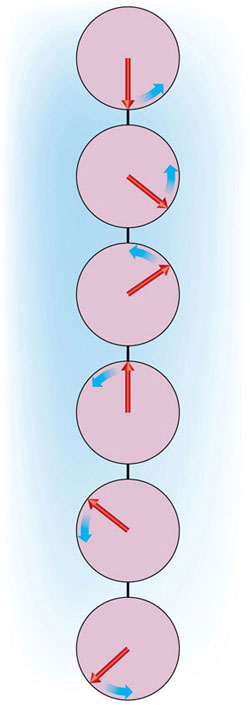| Mar 04, 2011 | |
Predicting a chain of order |
|
(Nanowerk News) The properties of a material are greatly affected by the electrical and magnetic structure of its constituent ions and electrons. In a ferromagnet, for example, neighboring electron spins point in the same direction, producing a strong external magnetic field. In an antiferromagnet, however, neighboring spins point in opposite directions, negating its magnetism. This behavior can be exploited in devices ranging from switches to memory and computers.
 A one-dimensional chain of spins (red arrows), showing a chiral ordering (or spiral), which rotate (blue arrows) in response to incoming light radiatio Multiferroic materials exhibit an even richer physics—and an expanded set of applications—because their magnetic and electrical orderings are linked. However, the magnetic and electrical structuring of multiferroics is not yet completely understood. Now, Shunsuke Furukawa, Masahiro Sato and Shigeki Onoda of the RIKEN Advanced Science Institute, Wako, have successfully calculated how magnetic ordering arises in one-dimensional multiferroic materials—the simplest example of these materials ("Chiral Order and Electromagnetic Dynamics in One-Dimensional Multiferroic Cuprates"). This simplicity means that one-dimensional multiferroic materials are useful models for understanding multidimensional, or 'bulk', multiferroic materials. Their one-dimensional chain of spins can not only assume a variety of ferromagnetic and anti-ferromagnetic alignments, but they can also arrange into more complicated patterns, including spirals defined over long portions of the chain—referred to as 'long-range chiral order' (Fig. 1). Understanding these exotic patterns may lead to new foundational science, as well as new applications. In addition, a one-dimensional chain can also exhibit the electrical control of magnetic structure and the response to light that is characteristic of more complex multiferroics. Onoda and colleagues focused on describing the magnetic structure in a one-dimensional chain in terms of how strongly neighboring spins were coupled to each other. They began by using a computational technique that uniquely allows for the accurate treatment of an infinitely large collection of spins to construct a phase diagram describing how spin ordering changed as the type of spin-to-spin coupling in the material changed. Most notably, the diagram indicated that ferromagnetic coupling between nearest neighbors was much more likely to cause a long-range chiral order than anti-ferromagnetic coupling. |
|
| This observation successfully explained the experimentally observed spin ordering of several one-dimensional multiferroic cuprates. In particular, the research team was able to correctly predict that the bulk multiferroic material LiCu2O2, whose unique physics has drawn the attention of physicists for over a decade, exhibits chiral order and has a unique response to light. "These results confirm that one-dimensional multiferroics are an ideal laboratory for studying spin dynamics", says Onoda, and he feels that the calculations will promote studies on new one-dimensional multiferroics and other novel states of matter. |
| Source: RIKEN |
